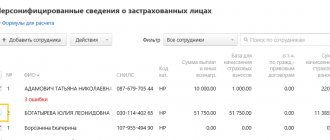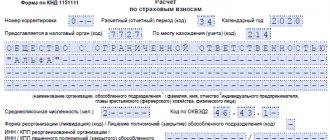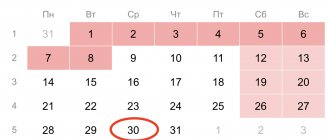What is RSV-1? This is a calculation of insurance premiums, which employers submit quarterly to the Federal Tax Service. He combined data on accruals for compulsory medical insurance, compulsory medical insurance and VNiM. The deadline for the 4th quarter is January 30, 2021.
The unified form of calculation for insurance premiums for 2021 (DAM) was approved by order of the Federal Tax Service of Russia dated September 18, 2019 No. ММВ-7-11/ [email protected] The report includes all information on existing insurance premiums, except for payments for occupational diseases and accidents on production, replacing the abolished report with the same abbreviation, but the number 1, and most sections of the 4-FSS form, which policyholders, as before, must submit to the Social Insurance Fund, but only for contributions “for injuries”. Form RSV-1 for the Pension Fund of the Russian Federation has been completely abolished and is no longer used by policyholders.
IMPORTANT!
SMEs from the list of affected industries have the right to apply contribution rates of 0% in the 2nd quarter (Law No. 172-FZ dated 06/08/2020). Letter No. BS-4-11/9528 of the Federal Tax Service of Russia dated 06/09/2028 defines the rules for indicating payer tariff codes. If the organization has the right to reduced tariffs, code 21 is indicated (in Appendix 5). Appendix 7 indicates codes indicating categories of individuals (KV and VZhKV). In this case, the report is filled out according to special rules: see the article “How to correctly fill out a zero calculation for insurance premiums.”
Features of submitting the DAM for the 3rd quarter of 2021 to the tax office
Due to the coronavirus shocks, everyone has forgotten a little about the rules for submitting payment calculations, updated for 2021. Let's remind them:
- if the number of persons included in the calculation exceeded 10 people the calculation is submitted only electronically through TKS channels (in 2021, the maximum number of insured persons allowing submission of a report on paper was 25 people);
- Those policyholders who have less than 10 employees also have the right to submit a calculation electronically - in this case this is not an obligation, but a right ;
- the paper version of the report can be delivered to the Federal Tax Service (either personally or through a representative) or sent by registered mail with a list of attachments;
- You must submit the DAM for the 3rd quarter of 2021 no later than October 30, 2020 (this is Friday, so there are no postponements).
Read also
12.02.2020
Section 1
Section 1 is final. In field 001, code “1” is entered if payments were made to individuals in the last 3 months. If there were none, code “2” is set. In line 010 OKTMO is written.
Next, in the lines of the section for each type of contribution you need to indicate:
- KBK;
- the amount of contributions for the reporting period;
- monthly contribution amounts.
This completes filling out the RSV form for 2021. Please note that the new section 5.1, intended for the IT sector, must be completed starting in 2021 when reporting for the 1st quarter. Those who send the DAM electronically should remember that the format for its presentation has also been changed.
The deadline for submitting calculations remains the same - no later than the 30th day of the month following the end of the quarter. You must submit the DAM for 2021 by February 1: the deadline is being moved, since January 30 is a Saturday.
Reporting of separate divisions
If the payer of insurance premiums has separate divisions that independently pay salaries to employees, then, by virtue of paragraph 7 of Article 431 of the Tax Code of the Russian Federation, each such division is obliged to submit a report to the tax authority at its location. In this case, it does not matter whether the separate division has its own separate balance sheet and current account. Moreover, the organization is obliged to notify the tax service in advance about the powers of its separate divisions to accrue and pay benefits to employees within a month, as provided for in Article 23 of the Tax Code of the Russian Federation. This obligation for all payers of insurance payments arose from 01/01/2018, and parent organizations declare themselves by submitting an application, the form of which is approved by order of the Federal Tax Service of Russia dated 01/10/2017 No. ММВ-7-14 / [email protected]
To fill out the report without errors, use free instructions and samples from ConsultantPlus experts.
Filling rules
Detailed explanations of how to fill out the calculation of insurance premiums are given in Appendix No. 2 to the order by which it was approved. Pages must be numbered consecutively. When filling out a document on a computer for further printing, you must use only the Courier New font size 16-18.
There is no need to round the cost figures in the report, indicating rubles and kopecks. If there is no indicator in the field, put dashes; if there is no value indicator, enter zeros. Any corrections, stapled sheets, or double-sided printing of the document are strictly prohibited. Please note that you no longer need a sample for filling out the RSV-1 - the Pension Fund of the Russian Federation does not request this document in 2021, although it has the right to fine you for failure to submit a report before 2021, when this process was administered (see the resolution of the Volga-Vyatka District AS dated December 24. 2018 in case No. A29-4848/2018).
How to fill out a DAM report: step-by-step instructions
The form is quite lengthy, so let’s look at filling out the calculation step by step. For example, let's take an organization that began operating in the 4th quarter of 2021. It employs two people, including the director. One specialist provides legal services under a civil law contract; payments in his favor are not included in the tax base for compulsory social insurance in case of temporary disability and in connection with maternity.
Step 1. Title page.
Here you must indicate the TIN, KPP and the full name of the organization - the payer of insurance premiums or full name. IP. We fill in the billing period code without errors. In reporting for the 4th quarter of 2020, we indicate code 34. You should also write the reporting year and the code of the tax authority to which the report was sent.
Next, we indicate the phone number, OKVED2 and the total number of calculation pages.
In addition, it is necessary to note who sends the report: the payer of insurance premiums himself or his representative. The payer corresponds to code 1, and the representative - 2. The date must be put at the end of the sheet, and the authorized person must certify the entered information with his signature.
Step 2. Section 1.
It contains summary data on the payer’s obligations, so it must indicate the correct BCC code for each type of payment. Accrued amounts are given monthly, separately for pension, social and medical insurance.
If there was additional insurance during the reporting period, this is also indicated separately. The entire section 1 does not fit on one page, so you must continue filling it out on the next one. At the bottom of each page you must put a signature and date of completion.
Step 3. Appendix 1 to Section 1 “Calculation of the amounts of insurance contributions for compulsory pension and health insurance.”
Here you should indicate separately calculated insurance payments for pension and health insurance and the number of insured persons in each month.
To fill out the payer's tariff code, select one of the indicators. The instructions on how to fill out the calculation of insurance premiums, given in the order of the Federal Tax Service, recommend indicating:
- 01 - with AHF;
- 02 - under the simplified tax system (this code is valid from 2021 to replace the previously used code 08);
- 03 - UTII.
Subsection 1.2 “Calculation of contributions for compulsory health insurance” is completed in the same way.
Step 4. Appendix 2 to Section 1 “Calculation of the amounts of insurance contributions for compulsory social insurance in case of temporary disability and in connection with maternity.”
Data on amounts calculated for the reporting period are provided. Indicate the number of insured persons and the amount of benefits paid. If maternity benefits were paid during the reporting period, an example of filling out a calculation of insurance premiums for a maternity leaver will help to correctly reflect the amount of benefits paid in connection with childbirth and maternity.
The next page indicates the amounts of calculated payments and the amounts spent on the payment of insurance coverage. We write separately the amount of contributions reimbursed by the Social Insurance Fund.
Next, indicate the amount to be paid.
To fill out the “Character” field, you must select:
- 2 - if the benefit is calculated and paid by the company;
- 1 - if payments are made from the Social Insurance Fund.
Step 5. Section 3. “Personalized information about insured persons.”
Here you need to fill in the details of each employee or person in whose favor the remuneration was paid in the reporting period. A separate sheet is filled out for each person. It indicates the reporting period code, date of completion, TIN, serial number for the section.
After this, the full name, INN, SNILS, gender and date of birth of each person must be entered into the reporting of insurance premiums.
Information about an identity document and a sign of insurance for each type of insurance are also required. Next comes information about the amount of payments and calculated contributions.
We found out that you can fill out an online calculation of insurance premiums for free in the taxpayer’s personal account on the website of the Federal Tax Service of Russia.
When will you have to pay?
So, is sick leave subject to insurance premiums? No. But if it is customary for an enterprise to pay certain amounts in addition to state benefits in order to bring the payment up to the average earnings, then they already have to pay interest to the Pension Fund and other funds. According to the law, such additional payments are not compensation, but are considered as additional income for the employee. Therefore, in this case, it is necessary to apply the rules for calculating payments to social funds that are common to all other types of income.
There is another situation when the employer will have to pay social insurance from sick leave - the Social Insurance Fund did not accept for deduction the amount of benefits calculated and paid to the employee. Officials emphasize that if the company has not received compensation from the social insurance fund, then the payment cannot be considered a benefit exempt from contributions. And in other cases, when receiving income, it is necessary to “share” with the state.
Reasons for refusing reimbursement
Fund employees may refuse to compensate the employer’s expenses if:
- the benefit was calculated incorrectly (the length of service, the average salary were not accurately determined);
- initially, the documents were drawn up by medical workers with violations (although there are already court decisions that recognize such actions of the FSS as illegal, see, for example, Resolution of the Supreme Court of the Russian Federation of September 29, 2015 No. F01-3911/2015 in case No. A38-6283/2014);
- all the data necessary for the calculation are not provided;
- documents were not properly completed if the worker was injured due to an industrial accident.
All employees for whom Social Security contributions are paid, if they fall ill, have the right to receive sick leave benefits. It is calculated on the basis of a sick leave certificate, which is issued by a doctor when the employee himself is ill or if care is needed for a sick child, as well as another family member. Pregnant women are also given sick leave before going on maternity leave.
Are sick leaves subject to insurance premiums? Our article will answer this question.
How to apply a reduced tariff - formulas from the Federal Tax Service
After the publication of the law, accountants of small and medium-sized enterprises had many questions. Here are some of them.
How to apply a reduced tariff when calculating contributions if the regulations refer to payments, and contributions are calculated from the base?
How can I distribute amounts across applications with different rate codes?
What to do if the employee’s payments amounted to 16,000 rubles (more than the minimum wage), but 5,000 of them are disability benefits, which are not subject to taxation?
What to do if the base limit has been reached? Should non-taxable payments be distributed according to tariffs in proportion to the minimum wage and the part exceeding it?
The Federal Tax Service explained how to apply the norms of 102-FZ, and published the formulas by which SMEs must calculate contributions (letter of the Federal Tax Service dated April 29, 2020 No. BS-4-11 / [email protected] ). If we adapt them to 2021, we get the following formula:
Minimum wage payments from the beginning of the year × 30% + (base from the beginning of the year - minimum wage payments from the beginning of the year) × 15% - contributions accrued from the beginning of the year.
Minimum wage payments are the amount of payments that is less than or equal to the minimum wage at the beginning of the billing period.
For example, to calculate contributions for January, February and March, perform the following calculation:
- for January: minimum wage payments × 30% + (base for January - minimum wage payments) × 15%.
- for February: minimum wage payments for 2 months × 30% + (base for 2 months - minimum wage payments for 2 months) × 15% - contributions calculated for January.
- for March: minimum wage payments for 3 months × 30% + (base for 3 months - minimum wage payments for 3 months) × 15% - contributions calculated for January-February.
Then proceed by analogy.
When the tax base reaches the limit, tax the excess amount at a reduced rate above the limit. To do this, exclude the excess amount from the base from the beginning of the year. The procedure for calculating the taxable base in the month of excess was explained by the Federal Tax Service in a letter dated July 13, 2020 No. BS-4-11/11315.
Features of the refined calculation
Errors in the form will traditionally lead to the need to submit an updated calculation. This point is regulated by Article 81 of the Tax Code of the Russian Federation, which states that only those sections of the document in which errors or inaccuracies were made will have to be filled out again. There is no need to duplicate sheets filled out without errors. Particular attention should be paid to section 3; it is submitted for each insured person separately, and clarifications should be submitted only for those persons whose data has been changed.
In some cases, mistakes made by the policyholder lead to the fact that the reporting on insurance premiums is considered not provided at all. In particular, this will happen if during the reporting period the total amount of insurance premiums does not coincide with the amount for each insured person. If such a discrepancy is detected, the territorial body of the Federal Tax Service is obliged to notify the policyholder that his report has not been accepted no later than the day following the day the document is sent to the tax office. From this moment the policyholder has 5 working days to correct his calculation. If he meets this deadline, the date of the form is considered to be the original date of its submission.
Form
Let's see what the insurance premium calculation form for the 4th quarter of 2021 consists of. The form contains 11 sheets (including attachments) and consists of:
- title page;
- Section 1 “Summary data on the obligations of the payer of insurance premiums”;
- Section 2 “Summary data on the obligations of insurance premium payers - heads of peasant (farm) farms”;
- Section 3 “Personalized information about insured persons.”
Which section needs to be completed and to what extent depends on the status of the policyholder and the type of activity he carries out. The table shows the categories of employers and the subsections of the calculation that they must fill out.
| Insured category | What to fill in the calculation |
| All policyholders are payers of insurance premiums (legal entities and individual entrepreneurs, except heads of peasant farms) |
|
| In addition, you must fill out: | In addition to the above: |
| Insurers who have the right to apply reduced or additional rates of social payments |
|
| Insurers who, during the reporting period, had expenses associated with the payment of compulsory social insurance to individuals in the event of temporary disability and in connection with maternity |
|
Validity period of preferential tariffs and procedure for their application
These benefits have no restrictions on the period of use. Until December 31, 2021, this norm is regulated by 102-FZ, and from 2021, taxpayers must be guided by the amendments made to Art. 427 Tax Code of the Russian Federation.
Since the changes were made on April 1, the benefit must be applied from April accruals. The date of accrual of wages in accounting is the last day of the month, therefore the previous rate should be applied to March payments. At the same time, if the bonus for March is accrued in April, then such payments fall under preferential treatment (letter of the Ministry of Finance No. 03-15-06/38515 dated June 20, 2017).
The presence of a non-taxable amount may lead to an error
If there is a non-taxable amount in the accruals, a mistake can be made. For example, the amount of an employee’s salary consists of a basic accrual of 26,000 rubles. and sick leave payments – 4,000 rubles, which is not subject to taxation. If you divide the taxable amount (RUB 26,000) proportionally, an error will be generated when checking the control ratios.
Incorrect section filling:
Incorrect completion of section 3 (code HP)
Incorrect completion of section 3 (MC code)
If the employee’s income contains non-taxable amounts, then according to the NR in block 150 it is necessary to indicate an amount equal to the minimum wage - 12,130 rubles, and in line 170 - the amount of the accrued contribution at a rate of 22%. According to the MR line, the accrued sick leave must be subtracted from the excess amount, and the resulting result is entered in block 150. Accordingly, contributions at a reduced rate (10%) will be calculated from this amount.
Correct filling of the section:
Correct completion of section 3 (code HP)
Correct completion of section 3 (MS code)










